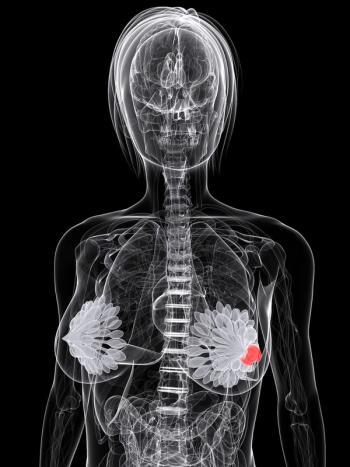
T-DXd Granted Breakthrough Therapy Designation by FDA in HER2+ Breast Cancer
The regulatory decision is based on data from the phase 3 DESTINY-Breast09 results presented at the 2025 ASCO Annual Meeting.
The FDA has granted fam-trastuzumab deruxtecan-nxki (T-DXd; Enhertu) breakthrough therapy designation as a first-line treatment for adult patients with unresectable or metastatic HER2-positive breast cancer, according to a news release from the drug’s developer, Daiichi-Sankyo.1
Based on results from the
Among patients treated with either T-DXd and pertuzumab (Perjeta; n = 383) or taxane, trastuzumab (Herceptin), and pertuzumab (THP; n = 387), the median progression-free survival (PFS) per blinded independent committee review (BICR) was 40.7 months (95% CI, 36.5-not calculable [NC]) vs 26.9 months (95% CI, 21.8-NC), respectively (HR, 0.56; 95% CI, 0.44-0.71; P <.00001), for a difference of about 13.8 months. Additionally, the respective 6-, 12-, and 24-month PFS rates were 93.0% (95% CI, 89.9%-95.2%) vs 87.8% (95% CI, 84.0%-90.7%), 85.9% (95% CI, 81.9%-89.1%) vs 72.4% (95% CI, 67.4%-76.8%), and 70.1% (95% CI, 64.8%-74.8%) vs 52.1% (95% CI, 46.4%-57.5%).
Additionally, the BICR-assessed objective response rate (ORR) in the T-DXd and THP arms was 85.1% (95% CI, 81.2%-88.5%) vs 78.6% (95% CI, 74.1%-82.5%), with 70.0% and 70.0% of patients in each arm attaining a partial response, and 15.1% vs 8.5% attaining a complete response. The median duration of response (DOR) in the respective arms was 39.2 months (95% CI, 35.1-NC) vs 26.4 months (95% CI, 22.3-NC), with 73.3% vs 54.9% of patients remaining in response at 24 months of treatment.
Early overall survival (OS) data suggest a positive trend favoring the T-DXd combination vs THP (HR, 0.84; 95% CI, 0.59-1.19).
“This breakthrough therapy designation provides further recognition of the potential benefit of [T-DXd] in combination with pertuzumab in the first-line setting of HER2-positive metastatic breast cancer,” Ken Takeshita, MD, global head R&D at Daiichi Sankyo, said in the news release.1 “If approved, [T-DXd] will continue to redefine the treatment of metastatic breast cancer as these latest results from DESTINY-Breast09 demonstrate a median PFS of more than 3 years when using [T-DXd] plus pertuzumab in this disease setting, which is an improvement over the current standard of care that has been in place for more than a decade.”
Patients with HER2-positive advanced/metastatic breast cancer with a disease-free interval of more than 6 months since last chemotherapy or HER2-targted neoadjuvant/adjuvant therapy were randomly assigned 1:1:1 to receive T-DXd plus placebo (n = 387), T-DXd plus pertuzumab (n = 383), or THP. The planned interim analysis presented at ASCO reported results from the T-DXd/pertuzumab and THP arms with a data cutoff date of February 26, 2025.
In the T-DXd and THP arms, the median age was 54 years (range, 27-85) and 54 years (range, 20-81), respectively. A total of 49.1% vs 49.4% of patients were from Asia, 66.8% vs 63.6% had an ECOG performance score of 0, and 83.0% vs 81.4% had IHC 3+ disease. Most patients had hormone receptor (HR)-positive disease (54.0% vs 54.0%), de-novo disease at diagnosis (52.2% vs 51.7%), or visceral metastases (73.4% vs 69.3%).
The primary end point of the study was PFS per BICR. A key secondary end point was OS, with additional secondary end points including investigator-assessed PFS, ORR, DOR, and PFS2, as well as safety and tolerability.
As of the data cutoff date, 59.7% of patients have discontinued T-DXd in the T-DXd combination arm, including 21.3% due to disease progression, 20.8% due to adverse effects (AEs), and 11.1% due to patient decision. In the THP arm, 96.3% of patients discontinued taxane therapy, with 43.6% of patients completing the minimum 6 cycles of taxane per protocol, 25.8% discontinuing due to AEs, and 18.8% due to disease progression. Trastuzumab was discontinued in 66.6% of this arm, primarily due to disease progression (52.5%).
Any grade treatment-emergent AEs (TEAEs) were observed in 99.7% vs 99.0% of patients in the T-DXd and THP arms. Possibly related treatment-related AEs (TRAEs) per investigator assessment occurred in 97.9% vs 96.6% of the respective arms, of which 54.9% vs 52.4% were at least grade 3 in severity. Serious TEAEs occurred in 27.0% of the T-DXd arm and 25.1% of the THP arm.
TEAEs associated with dose interruptions, dose reductions, or treatment discontinuation occurred in 68.8% vs 49.0%, 45.9% vs 19.9%, and 20.7% vs 28.3% of the respective arms. Fatal TEAEs occurred in 3.4% vs 0.8% of the respective arms, with 1.3% vs 0.3% considered possibly related to treatment.
References
- ENHERTU® plus pertuzumab granted breakthrough therapy designation in the U.S. as first-line therapy for patients with HER2 positive metastatic breast cancer. News release. Saiichi-Dankyo. July 17, 2025. Accessed July 18, 2025. https://tinyurl.com/yyvfzskc
- Tolaney SM, Jiang Z, Zhang Q, et al. Trastuzumab deruxtecan (T-DXd) + pertuzumab (P) vs taxane + trastuzumab + pertuzumab (THP) for first-line (1L) treatment of patients (pts) with human epidermal growth factor receptor 2–positive (HER2+) advanced/metastatic breast cancer (a/mBC): Interim results from DESTINY-Breast09. J Clin Oncol. 2025;43(suppl 17):LBA1008. doi:10.1200/JCO.2025.43.17_suppl.LBA1008
Newsletter
Stay up to date on recent advances in the multidisciplinary approach to cancer.
















































































